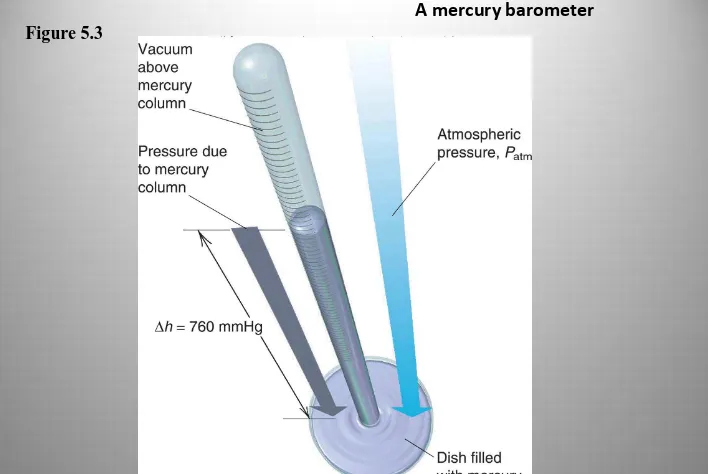Solid, Liquids, and Gases
The three states of matter.
Gases
• Because gases have so much space between
Gas Variables
• Volume (V) - mL, L, kL…
• Temperature (T) – oC measured in lab but K
(kelvin) for calculations
• Number of particles (n) – moles
Pressure
Figure 5.3
A mercury barometer
Table 5.1 Common Units of Pressure
Atmospheric Pressure
Unit Scientific Field
chemistry
atmosphere(atm) 1 atm* pascal(Pa);
kilopascal(kPa)
1.01325x105Pa;
101.325 kPa
SI unit; physics, chemistry
millimeters of mercury(Hg)
760 mm Hg* chemistry, medicine, biology
torr 760 torr* chemistry
pounds per square inch (psi or lb/in2)
14.7lb/in2 engineering
bar 1.01325 bar meteorology, chemistry, physics
*This is an exact quantity; in calculations, we use as many significant figures as necessary.
Gas Variable Relationships
• To investigate the relationship between 2 gas variables we need to hold the other 2
constant.
• Constant P - same # of collisions/unit area • Constant V - rigid container
• Constant T – thermostat control
The Relationship Between Pressure and Volume
The relationship between the volume and pressure of a gas.
Boyle’s Law
1 1 2 2
PV = P V
The relationship between the
volume and temperature of a gas.
The relationship between pressure and temperature
•As temperature
increases, gas particles move faster and make more collisions. As a
result the pressure in the container increases.
•For an aerosol can the pressure may be so great that the seam on the can may give way in an
An experiment to study the relationship between the volume and amount of a gas.
V n or V = constant x n
Solids and Liquids
• Because the particles are so much closer in liquids and solids, there are chances for
particles to attract (or repel). This and the mass of the particles are main factors in determining the properties of solids and liquids.
• Some properties are boiling and melting
Surface Tension
• Surface tension is the tendency for liquid surface to contract.
• Depends on attractive forces
• Compounds that
interfere with the forces and reduce surface
tension are called
The molecular basis of surface tension.
hydrogen bonding occurs in three
dimensions hydrogen bonding occurs across the surface
and below the surface
Shape of water or mercury meniscus in glass.
adhesive forces
stronger cohesive forces
H2O
capillarity
Solids
• Solids may have a definite structure and are called crystalline.
portion of a 3-D lattice
The crystal lattice and the unit cell.
lattice point
unit cell
portion of a 2-D lattice unit
Phase Changes
Energy absorbed

